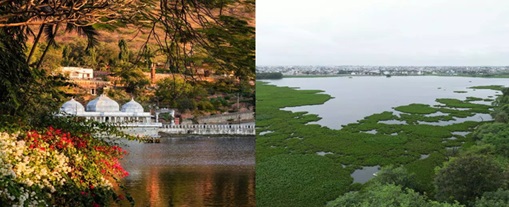Why in the NEWS?
- Indore and Udaipur became the first Indian wetland cities to receive international recognition under the Ramsar Convention.
- Bhopal was also nominated, it could not join due to ecological concerns.

Key Points:
- Indore (Madhya Pradesh) and Udaipur (Rajasthan) were given this recognition for the effective steps taken by them to conserve their natural and man-made wetlands.
- Union Environment Minister Bhupender Yadav termed it a "double pleasure" and said that this achievement reflects India's commitment to ecological conservation along with urban and rural development.
- Bhopal, which was nominated along with Indore and Udaipur, could not make it to the list.
- The proposed road project in the catchment area of Bhoj Wetland, which could have posed a threat to its ecosystem and wildlife.
What will you read next in this topic?
- Importance of Wetlands of Indore and Udaipur.
- Importance of Wetlands in India.
- Historical Background of Ramsar Convention.
- Urbanisation and threats to wetlands.
- India's role in Ramsar sites.
- Importance of international recognition.
- Involvement of local communities.
- Role of wetlands in mitigating climate change.
Importance of Wetlands of Indore and Udaipur
- Indore:
- The city has many lakes and water bodies, prominent among them being Sirpur Lake and Yashwant Sagar.
- These are not only important for biodiversity but also play a vital role in maintaining local water supply and environmental balance.
- Udaipur:
- Called the 'City of Lakes', it includes famous wetlands like Fatehsagar, Pichola and Udaisagar Lake.
- These lakes are not only important from an environmental point of view but are also a major source of tourism and economic development.
Importance of Wetlands in India
- About 7.7 million hectares of area in India is covered with wetlands, which contribute to climate balance, groundwater recharge and carbon absorption.
- These areas are important habitats for migratory birds and maintain biodiversity.
Historical Background of Ramsar Convention
- The Ramsar Convention was established in 1971 in the city of Ramsar, Iran.
- It aims to promote the sustainable use and conservation of wetlands.
- Currently, 172 countries are members, and more than 2,500 wetlands are recognised as Ramsar sites globally.
Urbanisation and threats to wetlands
- Many wetlands in India are facing the threat of pollution, encroachment and climate change due to rapid urbanisation and industrialisation.
- Plastic pollution, waste disposal and use of chemicals in lakes and water bodies are disrupting their ecological balance.
India's role in Ramsar sites
- India has designated 85 wetlands as Ramsar sites.
- These include major wetlands such as Chilika Lake (Odisha), Wular Lake (Jammu and Kashmir), and Deepor Beel in Assam.
- This initiative reflects India's commitment to the conservation of biodiversity and water resources.
Importance of international recognition
- The recognition of Indore and Udaipur recognises India's ecological conservation efforts on a global platform.
- This will set an example for other Indian cities, which will be inspired to conserve their water bodies and wetlands.
Involvement of local communities
- Involvement of local communities is being encouraged in the conservation of wetlands.
- Awareness campaigns, cleanliness programmes and promotion of wetland-based livelihoods can ensure that wetlands provide not only environmental but also socio-economic benefits.
Role of wetlands in mitigating climate change
- Wetlands act as natural carbon sinks and help absorb atmospheric carbon dioxide.
- They are helpful in preventing floods, reducing soil erosion and mitigating the effects of climate change.
|
Q. What is the main objective of the Ramsar Convention?
(a) Conservation of forests
(b) Conservation of wetlands and their resources
(c) Controlling climate change
(d) Conservation of marine ecosystem
|



